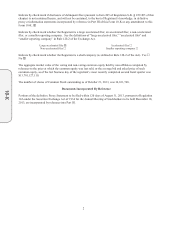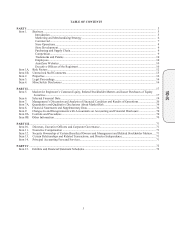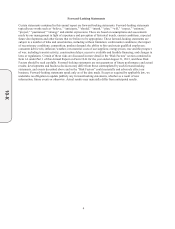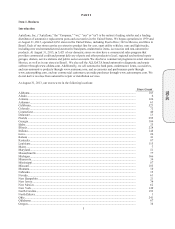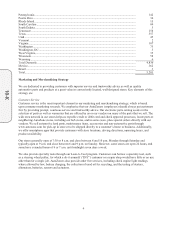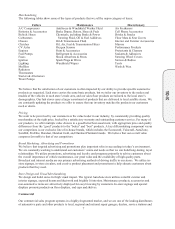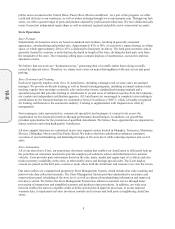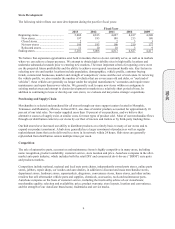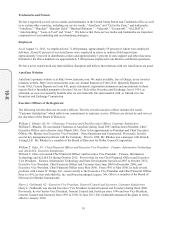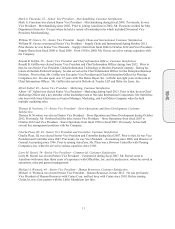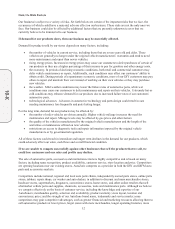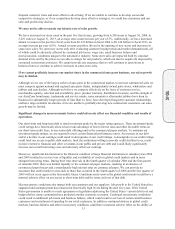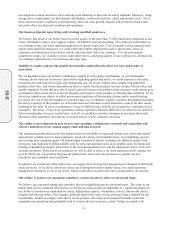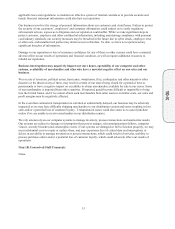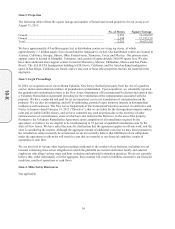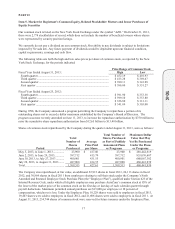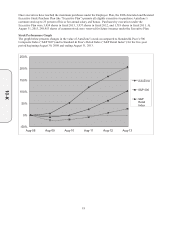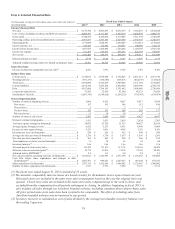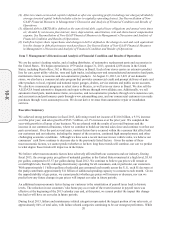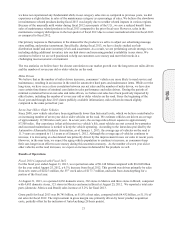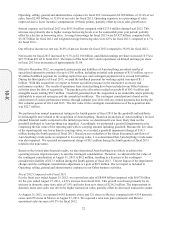AutoZone 2013 Annual Report Download - page 74
Download and view the complete annual report
Please find page 74 of the 2013 AutoZone annual report below. You can navigate through the pages in the report by either clicking on the pages listed below, or by using the keyword search tool below to find specific information within the annual report.
12
Item 1A. Risk Factors
Our business is subject to a variety of risks. Set forth below are certain of the important risks that we face, the
occurrence of which could have a material, adverse effect on our business. These risks are not the only ones we
face. Our business could also be affected by additional factors that are presently unknown to us or that we
currently believe to be immaterial to our business.
If demand for our products slows, then our business may be materially affected.
Demand for products sold by our stores depends on many factors, including:
• the number of vehicles in current service, including those that are seven years old and older. These
vehicles are generally no longer under the original vehicle manufacturers’ warranties and tend to need
more maintenance and repair than newer vehicles.
• rising energy prices. Increases in energy prices may cause our customers to defer purchases of certain of
our products as they use a higher percentage of their income to pay for gasoline and other energy costs.
• the economy. In periods of declining economic conditions, both retail and commercial customers may
defer vehicle maintenance or repair. Additionally, such conditions may affect our customers’ ability to
obtain credit. During periods of expansionary economic conditions, more of our DIY customers may pay
others to repair and maintain their cars instead of working on their own vehicles or they may purchase
new vehicles.
• the weather. Mild weather conditions may lower the failure rates of automotive parts, while wet
conditions may cause our customers to defer maintenance and repair on their vehicles. Extremely hot or
cold conditions may enhance demand for our products due to increased failure rates of our customers’
automotive parts.
• technological advances. Advances in automotive technology and parts design could result in cars
needing maintenance less frequently and parts lasting longer.
For the long term, demand for our products may be affected by:
• the number of miles vehicles are driven annually. Higher vehicle mileage increases the need for
maintenance and repair. Mileage levels may be affected by gas prices and other factors.
• the quality of the vehicles manufactured by the original vehicle manufacturers and the length of the
warranties or maintenance offered on new vehicles.
• restrictions on access to diagnostic tools and repair information imposed by the original vehicle
manufacturers or by governmental regulation.
All of these factors could result in immediate and longer term declines in the demand for our products, which
could adversely affect our sales, cash flows and overall financial condition.
If we are unable to compete successfully against other businesses that sell the products that we sell, we
could lose customers and our sales and profits may decline.
The sale of automotive parts, accessories and maintenance items is highly competitive and is based on many
factors, including name recognition, product availability, customer service, store location and price. Competitors
are opening locations near our existing stores. AutoZone competes as a provider in both the DIY and DIFM auto
parts and accessories markets.
Competitors include national, regional and local auto parts chains, independently owned parts stores, online parts
stores, jobbers, repair shops, car washes and auto dealers, in addition to discount and mass merchandise stores,
hardware stores, supermarkets, drugstores, convenience stores, home stores, and other online retailers that sell
aftermarket vehicle parts and supplies, chemicals, accessories, tools and maintenance parts. Although we believe
we compete effectively on the basis of customer service, including the knowledge and expertise of our
AutoZoners; merchandise quality, selection and availability; product warranty; store layout, location and
convenience; price; and the strength of our AutoZone brand name, trademarks and service marks; some
competitors may gain competitive advantages, such as greater financial and marketing resources allowing them to
sell automotive products at lower prices, larger stores with more merchandise, longer operating histories, more
10-K


